Whether it’s the light of a fire, a bulb, or from a TV or phone, moths do not hesitate to dive straight into it.
In the natural world, the species that still exist today have endured thousands, if not millions, of years of evolution to adapt to their surrounding environment.
The evolution of each species varies, but it is primarily driven by two main objectives: Feeding – Survival. Some optimize their hunting abilities, such as speed (like leopards), strength (like tigers and lions), or camouflage, venom…
There are also species that simply need to exist and fulfill nature’s mission of perpetuating their kind! Such species possess remarkable abilities to hide, camouflage, or sense danger to evade predators.

It seems that diving towards the light is an instinct of moths?
Nevertheless, regardless of the direction of evolution, most of them develop towards maximizing survival in the natural world, meaning every species needs to survive. However, a few do not follow this trend!
A prime example is the moth. Its scientific name is Ephemeroptera (mayflies), which typically appear mainly during mating season and then die shortly after.
The reason for the moth’s death is quite characteristic; even from its name, we can understand part of it. They are often “enchanted” by light, diving into it, and when attracted to sources like fire or high-intensity lamps, moths die almost instantly.
So why do moths dive into the light knowing it will lead to their death?
In reality, the time a moth can fly and live on land is very short, only a few hours, while they mostly exist in their larval form, living underwater, which can last from 1 to 3 years!
As of now, there is still no definitive answer despite many hypotheses put forth. This is considered one of the biggest questions for entomologists.

The time moths can fly and live on land is very short.
1. Hypothesis about Eyes
The most widely accepted hypothesis from many scientists revolves around the eyes of moths. Professor Saunders, an entomologist at Penn State, explains: “Moths typically use the moon to orient themselves during their night flights.”
Accordingly, the moon is considered a visual infinity, meaning it is a light source far enough that the rays reach Earth parallel to each other. Indeed, it is an excellent navigation method; by using light from the moon as a reference, they can move in a specific direction.
However, this “technology” has a fatal flaw. Artificial light sources are much closer, brighter, and more attractive than the moon. When these appear, moths will become quite “confused.”
These rays enter part of their eyes, causing their navigation system to become disrupted. Consequently, the moths lose their original orientation (from moonlight), spiral off course, and gradually fly directly into the flame.

Are moths diving into flames due to instinct, attraction, fascination, or “getting lost”?
2. Hypothesis about Reproduction
In addition to the reason mentioned above, many scientists offer another explanation. Philip Callahan, an American entomologist, suggests: “The infrared light spectrum emitted by a burning candle can emit frequencies that match exactly with the light emitted by a female, hence male moths are stimulated to rush towards it.”
This explains why so many males perish in the heat of the flames. However, this hypothesis still has many gaps and faces considerable controversy.
As of now, the exact cause remains elusive, but scientists, especially entomologists, continue their quest to explain this seemingly straightforward yet profoundly mysterious natural phenomenon.
New Hypothesis on Why Insects Are Attracted to Light
In a study published in the journal Nature Communications in early 2024, authors from the Royal Holloway University of London discovered an unexpected behavior of insects. Many species, such as moths and dragonflies, always “turn their backs” to the light. They even fly upside down.

An image capturing a caterpillar turning its back to artificial light. (Photo: Royal Holloway University).
Based on 477 recorded videos analyzing insect behavior, researchers suggest that some insects fly toward the light as a way to self-navigate.
However, when light is placed near the ground, some of these insects, as mentioned, even fly upside down and fall to the floor. This indicates they are entirely disoriented.
“Typically, light means flying up, and darkness means going down,” author Avalon Owens stated. “With artificial light, this rule is reversed, and where insects end up is not where they intended.”
While this experiment has revealed part of why insects prefer to be near light, it does not explain why they find light from a distance or why some become “trapped” in this light.
Researchers believe that this mystery will soon be unveiled with the help of camera technology and more sensitive analytical techniques. “Humans do not yet have the necessary tools to explore these questions,” Owens emphasized.


















































